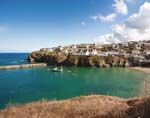National strategy required for coastal areas
Coastal areas must adapt to rising sea levels and extreme weather events, urges the National Trust


After a winter of violent storms and crashing waves, the National Trust is calling for a ‘clear, national strategy' to help coastal areas adapt to rising sea levels and extreme weather. The Trust's Simon Pryor says this winter has been a sharp reminder of the limited shelf life of ‘hard' sea defences and the question of whether ‘natural processes' should be given more space to work. ‘There is a natural inclination to defend the coastline with concrete, but our coastline is dynamic and the forces of nature that have formed it are part of its beauty,' he explains.
The charity's report, Shifting Shores, argues that more use of ‘soft' defences, such as marshes and sand dunes, could take the power out of storm surges. At Gower in South Wales, where a wall has prevented the sea from inundating farmland for centuries, the Trust is contemplating the long-term viability of keeping the sea out and whether it should return the area to salt marsh. Its report predicts that some 380 miles of coast, affecting 169 of its sites, could lose land to erosion in the next century and that 10% of this loss could stretch from 325ft to 650ft inland.
It maintains that, although national planning policy sets a good framework for councils to manage coastal change, ‘there is too little evidence that this framework is being reflected in local plans'. It says there should be ‘a clearer mechanism for people to find out if their home or business lies within a coastal erosion risk zone' and that it should be considered what assistance can be given to homes and businesses under threat ‘in lieu of investing large sums on renewing sea defences'.
However, according to the Wildlife Trusts, some threatened areas cannot be ‘rolled back' due to development pressures on the land behind. ‘There's no one-size-fits-all solution, although a move to greater use of "softer" solutions is critical,' suggests Paul Wilkinson. ‘There are some areas of coast where wild habitats such as saltmarsh are being squeezed against hard engineering structures, but other cases where the harder structures are actually helping to save fragile freshwater habitats that would otherwise be destroyed by the sea.'
* Follow Country Life magazine on Twitter
Sign up for the Country Life Newsletter
Exquisite houses, the beauty of Nature, and how to get the most from your life, straight to your inbox.
Country Life is unlike any other magazine: the only glossy weekly on the newsstand and the only magazine that has been guest-edited by HRH The King not once, but twice. It is a celebration of modern rural life and all its diverse joys and pleasures — that was first published in Queen Victoria's Diamond Jubilee year. Our eclectic mixture of witty and informative content — from the most up-to-date property news and commentary and a coveted glimpse inside some of the UK's best houses and gardens, to gardening, the arts and interior design, written by experts in their field — still cannot be found in print or online, anywhere else.
-
 Can't you hear me S.O.S? Our treasured native dog breeds are at risk of extinction
Can't you hear me S.O.S? Our treasured native dog breeds are at risk of extinctionDo you know your Kerry blue terrier from your Lancashire heeler? A simple lack of publicity is often to blame for some of the UK's native dog breeds flying dangerously low under-the-radar.
By Victoria Marston Published
-
 'There are architects and architects, but only one ARCHITECT': Sir Edwin Lutyens and the wartime Chancellor who helped launch his stellar career
'There are architects and architects, but only one ARCHITECT': Sir Edwin Lutyens and the wartime Chancellor who helped launch his stellar careerClive Aslet explores the relationship between Sir Edwin Lutyens and perhaps his most important private client, the politician and financier Reginald McKenna.
By Clive Aslet Published
